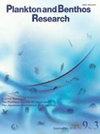在韩国马利波海滩,自由生活的海洋线虫,特别是Enoplolaimus spp.摄入微塑料
IF 0.6
4区 生物学
Q4 MARINE & FRESHWATER BIOLOGY
引用次数: 5
摘要
许多塑料会对海洋环境造成污染,其中微塑料(0.1µm-5 mm)是研究的重点。沉积物中的微塑料数量可能迅速增加,影响海洋沉积物中的生物。这项研究的目的是确定微塑料如何影响潮间带沙中的线虫。我们评估了:(1)enplolaimus spp.在48小时内摄入微塑料颗粒(10 μ m, 5 μ m, 1 μ m或0.5 μ m);(2)线虫在48小时内的微塑料摄取量取决于摄食类型(选择性沉积物摄取者、非选择性沉积物摄取者、附着性摄取者或捕食者/杂食者);(3) Enoplolaimus spp的微塑料摄取量。在10µm的微塑料处理下,Enoplolaimus spp个体中含有微塑料的比例显著低于5µm、1µm和0.5µm的微塑料处理。随着微塑料尺寸的减小,捕食者/杂食性动物、非选择性沉积物摄取者和选择性沉积物摄取者对微塑料的摄取量增加。摄食微塑料后将Enoplolaimus sp .转移到过滤后的海水中,3天内含有最小尺寸微塑料(0.5µm)的Enoplolaimus sp .个体比例下降了摄食量的15%。综上所述,不同微塑料粒径处理之间存在显著差异,但不同投喂方式之间及微塑料粒径与投喂方式之间的相互作用不存在显著差异。微塑料的大小,而不是线虫的摄食类型,影响摄食率。沉积物中的微塑料有可能是由海洋生态系统中的生物摄入的。本文章由计算机程序翻译,如有差异,请以英文原文为准。
Ingestion of microplastics by free-living marine nematodes, especially Enoplolaimus spp., in Mallipo Beach, South Korea
: Many plastics cause pollution in the marine environment, with microplastics (0.1 µ m–5 mm) representing a key research focus. The number of microplastics in sediments may increase rapidly, affecting organisms inhabiting marine sediments. The aim of this study was to determine how microplastics affect nematodes in intertidal sand. We assessed: (1) intake of microplastic particles (10 µ m, 5 µ m, 1 µ m, or 0.5 µ m) by Enoplolaimus spp. over 48 h; (2) microplastic intake by nematodes depending on feeding type (selective deposit feeders, non-selective deposit feeders, epistrate feeders, or predators/omnivores) over 48 h; and (3) microplastic egestion by Enoplolaimus spp. The proportion of Enoplolaimus spp. individuals containing microplastics was significantly less in the 10- µ m microplastic treatment than in the treatments where Enoplolaimus spp. were exposed to microplastic particles of smaller sizes (5 µ m, 1 µ m, or 0.5 µ m). The ingestion rates of microplastics by predators/omnivores, non-selective deposit feeders, and selective deposit feeders increased as the size of the microplastic decreased. After transferring Enoplolaimus spp. to filtered seawater following microplastic ingestion, the proportion of Enoplolaimus spp. individuals containing the smallest size microplastic (0.5 µ m) decreased by 15% of the ingested amount in 3 days. In conclusion, there was a significant differ ence among microplastic-size treatments, but not among feeding types or in the interaction between microplastic size and feeding type. The size of microplastics, rather than feeding type of nematodes, impacted ingestion rates. It is pos-sible that microplastics in the sediment are ingested by living in marine ecosystems.
求助全文
通过发布文献求助,成功后即可免费获取论文全文。
去求助
来源期刊

Plankton & Benthos Research
Agricultural and Biological Sciences-Aquatic Science
CiteScore
1.30
自引率
0.00%
发文量
32
期刊介绍:
Plankton and Benthos Research is a peer-reviewed journal publishing quarterly original papers, reviews and notes dealing with any aspect of the biology and ecology of planktonic and benthic organisms and their interactions with the environment in any aquatic system, and is open to all scientists around the world. Submission of a paper is held to imply that it represents an original contribution not previously published and that it is not being considered elsewhere.
 求助内容:
求助内容: 应助结果提醒方式:
应助结果提醒方式:


